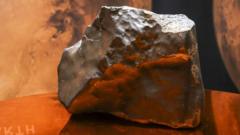The satellite's design incorporates panels made from magnolia wood, constructed without traditional fasteners, aligning with eco-friendly building practices. Kyoto University’s Prof. Koji Murata emphasizes wood's resilience in space, suggesting it could potentially replace metals in future spacecraft. "Wood is more durable in the vacuum of space, as it lacks the moisture and oxygen that typically cause deterioration," he explained.
With plans to explore the possibility of cultivating trees on other celestial bodies, the researchers aim to promote self-sustaining habitats for space explorers. Alongside the wood components, LignoSat includes aluminum structures and sensors to observe wood's behavior under extreme space conditions. Dr. Simeon Barber from the UK Open University recognizes the core idea of a wooden satellite as both interesting and sustainable, considering wood's renewability.
He notes that wood has been historically used in space missions, including cork insulation on re-entry vehicles and lunar landers. However, he cautions that while wood could offer reduced pollution during re-entry, challenges remain regarding its predictability and strength for vital spacecraft components. The satellite's development also raises awareness of the growing issue of space debris, prompting calls for innovative solutions in reducing space junk generated by increasing satellite launches.
As Kyoto University continues to advance its research, the implications of LignoSat may pioneer an environmentally-conscious path for the future of space exploration.
With plans to explore the possibility of cultivating trees on other celestial bodies, the researchers aim to promote self-sustaining habitats for space explorers. Alongside the wood components, LignoSat includes aluminum structures and sensors to observe wood's behavior under extreme space conditions. Dr. Simeon Barber from the UK Open University recognizes the core idea of a wooden satellite as both interesting and sustainable, considering wood's renewability.
He notes that wood has been historically used in space missions, including cork insulation on re-entry vehicles and lunar landers. However, he cautions that while wood could offer reduced pollution during re-entry, challenges remain regarding its predictability and strength for vital spacecraft components. The satellite's development also raises awareness of the growing issue of space debris, prompting calls for innovative solutions in reducing space junk generated by increasing satellite launches.
As Kyoto University continues to advance its research, the implications of LignoSat may pioneer an environmentally-conscious path for the future of space exploration.





















